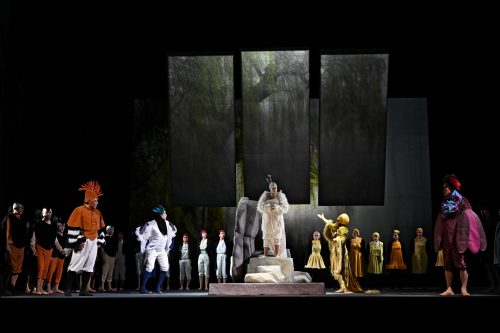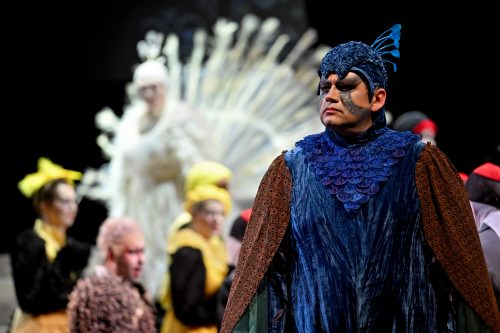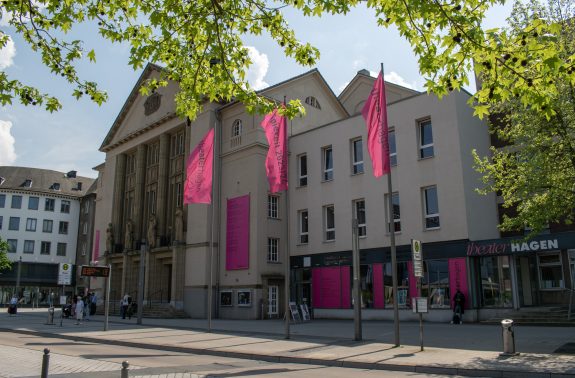 Germany Wagner, Lohengrin: Soloists, Chorus, Extra chorus and Extras of Theater Hagen. Philharmonic Orchestra Hagen / Joseph Trafton (conductor). Theater Hagen, 20.5.2024. (DMD)
Germany Wagner, Lohengrin: Soloists, Chorus, Extra chorus and Extras of Theater Hagen. Philharmonic Orchestra Hagen / Joseph Trafton (conductor). Theater Hagen, 20.5.2024. (DMD)

Production:
Director – Nelly Danker
Stage design and Video – Robert Pflanz
Costume design – Amélie Sator
Lighting design – Martin Gehrke
Dramaturgy – Francis Hüsers, Thomas Rufin
Chorus director – Julian Wolf
Cast
Heinrich der Vogler – Dong-Won Seo
Lohengrin – Tobias Haaks
Elsa von Brabant – Dorothea Herbert
Friedrich von Telramund – Insu Hwang
Ortrud – Angela Davis
The King’s Herald – Kenneth Mattice
Four Brabantine Nobles – Johan de Bruin, Sebastian Joest, Younjin Ko, Matthias Overmeyer
Duke Gottfried – Sarah Herrmann
Pages – Nino Müller, David Pamin
One of the leading German theatre magazines, Die Deutsche Bühne, named Theater Hagen as the best in the category of ‘Convincing theatre work located at some distance from major centres of theatre’ for 2018/19. This production of Lohengrin, premiered in March 2024, is a good example for the apparent continuation of this praise- and prizeworthy trend.
Possibly unique in the stage history of this opera, the creative team of director and above all costume designer Amélie Sator placed the action of the opera in the world of birds. Lohengrin was a blue peacock, Elsa a white peacock. Ortrud was a golden pheasant, King Heinrich a hoopoe, the herald a blue jay, Telramund a tragopan. This looked intriguing, although the large fan worn by Elsa was rather wobbly and Tobias Haaks as Lohengrin had some difficulty taking it off in the Act III. Some of the singers did more by way of imitating bird behaviours and movements – particularly Kenneth Mattice as the Herald was impressive in this respect. Others did less. The programme booklet provided some background information on the birds, but it did not add to the interpretation of the characters through the birds they were associated with. This truly creative idea was not taken far enough.
The set by Robert Pflanz for this bird world consisted of a combination of colourful and imaginatively designed projections onto three rectangular panels hung from the ceiling mid-stage, and onto the back wall and objects on the revolve, such as a structure of grey rocks (with predominantly rounded, rather than sharply chiselled edges). The bedroom in the third act was suggested by a bird’s nest filled with white pillows. The images created by this set were striking and as beautiful in colour as the bird costumes.

Tobias Haaks as Lohengrin was a convincing actor, although the make-up did not allow for much by way of facial expression. His singing was spot-on, with particular strength in the higher range of the voice, and the better the louder he was singing. There is much potential for the voice to develop further into the heroic, or perhaps even character, tenor field. Dorothea Herbert’s soprano was well ready for the role of Elsa: it was secure, clear, radiant, and equally pleasant across the range of pitch she was able to employ appropriately. Angela Davis contributed a powerful Ortrud. Her lower register was round and well developed, providing a profound basis for the singing in the upper range. Insu Hwang was able to give Telramund a multifaceted profile. There was a moving moment when he had accused Elsa and she appeared before the King. All the genuine love he had for her before she rejected his proposal was still present, and obvious from his reaction to her. Ortrud, his second choice as wife, saw this, and gently touched his arm, comforting him, not at all jealous or envious: full of concern for him, for his feelings, and content with her role in this context. Insu Hwang’s voice was robust and very musical. Dong-Won Seo sang the well-intentioned, forthright King Henry with sonorous bass voice. Kenneth Mattice gave his all as the Herald.
The orchestra was highly committed: Joseph Trafton, the company’s General Music Director, created an excellent balance between stage and pit, never drowning the singers’ voices while at the same time managing to create a nuanced soundscape with the small number of musicians that fit into the theatre’s pit.
Much promise here, then, and artists to look out for in the future.
Daniel Meyer-Dinkgräfe
Featured Image: Theater Hagen © Yuliana Falkenberg
